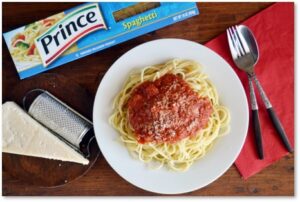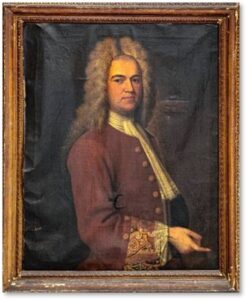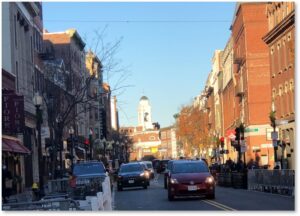Given that Boston changed the names of King Street and Queen Street after the Revolutionary War, why did the city keep Hanover Street and Prince Street? Wait. What does Hanover Street have to do with European royalty?
Jonathan Belcher’s European Tour
In the early 1700s, Jonathan Belcher, son of a prominent Boston family, traveled to the Netherlands and Germany to cultivate business contacts of his own with Dutch merchants and to secure military supply contracts.
After visiting Rotterdam and Amsterdam, he traveled to Hanover, where he was received by Electress Sophia. There, Mr. Belcher also met the future King of Great Britain, George, Duke of Brunswick-Lüneburg. After establishing a relationship with the future ruling dynasty of England in Hanover, he called on the Prussian court in Berlin.
Upon returning to New England, in 1708, Mr. Belcher announced Boston’s pride in Britain’s expanding empire by bestowing new names on Boston’s streets: Hanover Street, Orange Lane, and Marlborough Street (the victor in the Battle of Blenheim in 1704). Prince Street was likely also named after Prince George of Hanover.
Jonathan Belcher was later appointed Colonial Governor of both New Hampshire and Massachusetts, and then Governor of New Jersey. Belchertown, MA, is named for him.
NOTE: Orange Lane and Marlborough Street were later incorporated into Washington Street. Arthur D. Gilman re-used the Marlborough Street name in the Back Bay.
Prince Street
In 1643, Prince Street was a highway through the mill field that ran through Christopher Stanley’s field. Its many names included “Black Horse Lane” and “Bell Alley” for the two blocks between Hanover Street and North Street. It became Prince Street in 1708.
 Prince Street also gave us the name of a famous America’s brand and one indelibly associated with Boston’s North End—Prince® pasta and sauces. In 1912, three immigrants from Sicily started a small company in the North End to manufacture spaghetti.
Prince Street also gave us the name of a famous America’s brand and one indelibly associated with Boston’s North End—Prince® pasta and sauces. In 1912, three immigrants from Sicily started a small company in the North End to manufacture spaghetti.
They all came from the same Sicilian village. Michele Cantella, the pasta maker, was joined by Salesman Giuseppe Seminara and Administrator Gaetano LaMarca. When the Prince® company outgrew its offices it moved to Lowell, Mass.
These three immigrant entrepreneurs started a little North End company that would grow into one of the largest pasta manufacturers in the country. Thus did George, Duke of Brunswick-Lüneburg, lend his title to an Italian food he probably never ate, made by a company founded by Italian commoners. And if it wasn’t for Jonathan Belcher’s European tour, Wednesday might have been Black Horse Spaghetti Day.
Hanover Street
In the beginning, Hanover Street was an Indian path that ran through the Shawmut Peninsula to the water. One of the oldest of Boston’s streets, it was laid out partly through Christopher Stanley’s field and partly on land that had not been granted to anyone. It had, of course, many names including “the great street that runs down to the river” and “the Middle Back Street.”
The town finalized the name of Hanover Street from Sudbury Street to the Mill Bridge in 1708, when Boston stabilized its street names. It became Middle Street form the bridge to North Bennett Street and North Street from there to the water. The city consolidated the names into Hanover Street in 1824, although confusion remains between the two North Streets.
A Street of Churches
At different times, Hanover Street held the New North Church on the east corner of Clarke Street, the New Brick Church just east of Richmond Street, and a Mason’s Hall on a passage between Cross and Parmenter Streets. Old St. Stephen’s Church faces the Prado across Hanover Street.
Hanover Street once ran all the way from Commercial Street on the water to what is now Cambridge Street. In the 1950s it lost the block between Cross Street and Blackstone Street to construction of the Southeast Expressway. That block re-opened when the Big Dig replaced the elevated highway with the Rose Kennedy Greenway. More of Hanover Street disappeared, however, when the southern end from Congress Street to the current Cambridge Street was demolished in the urban renewal that created Government Center.
Hanover Street, named for a German prince and the grandfather of George III, is now the central thoroughfare of Boston’s Italian North End. You go there for pastries like cannoli, steaks, home-baked bread, and pasta dinners. I wonder what George I would have thought of that.
The Prince of Hanover Remained
The question remains of why King and Queen Streets were thrown out while streets named for the Prince of Hanover remained. So far, it’s a mystery.



